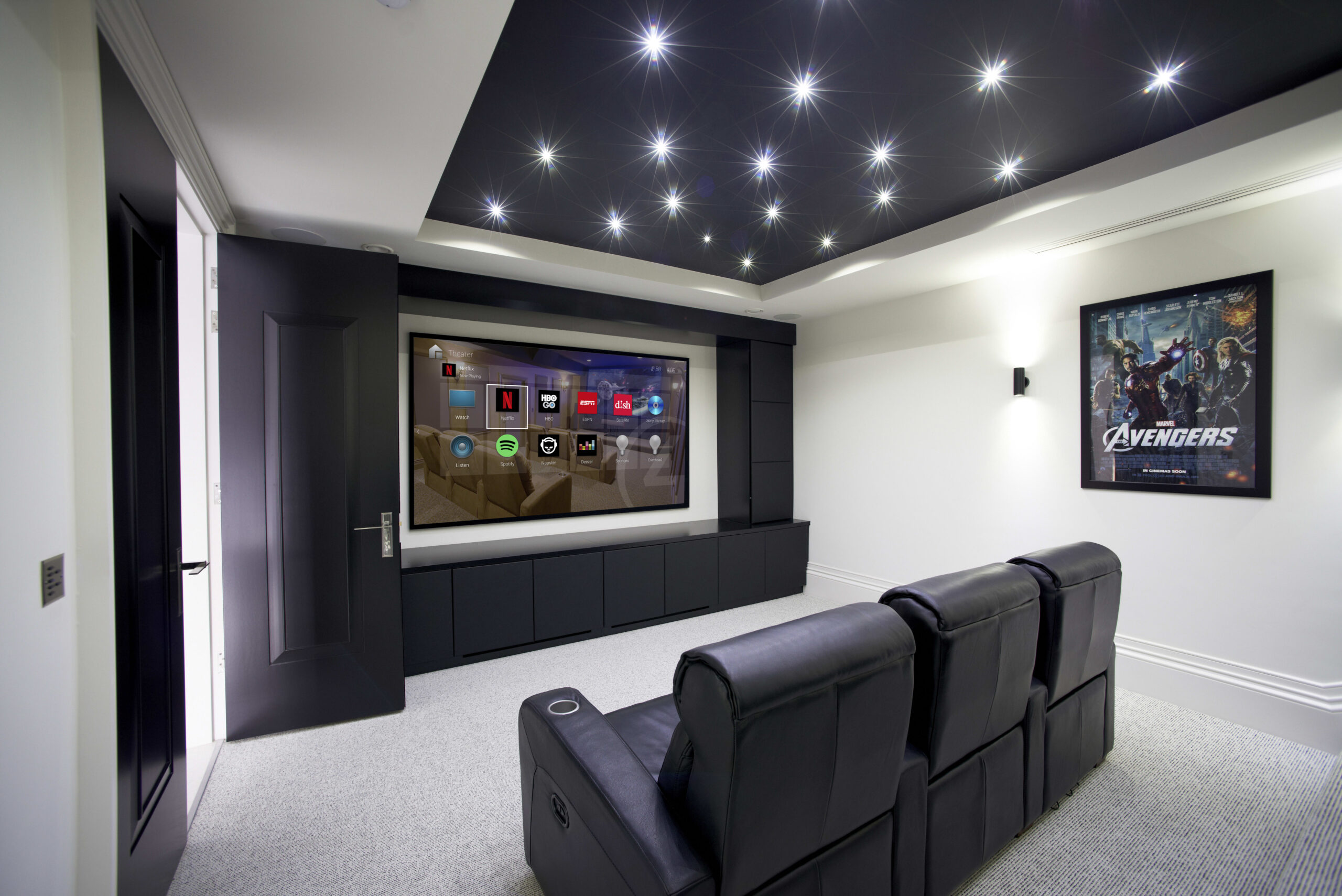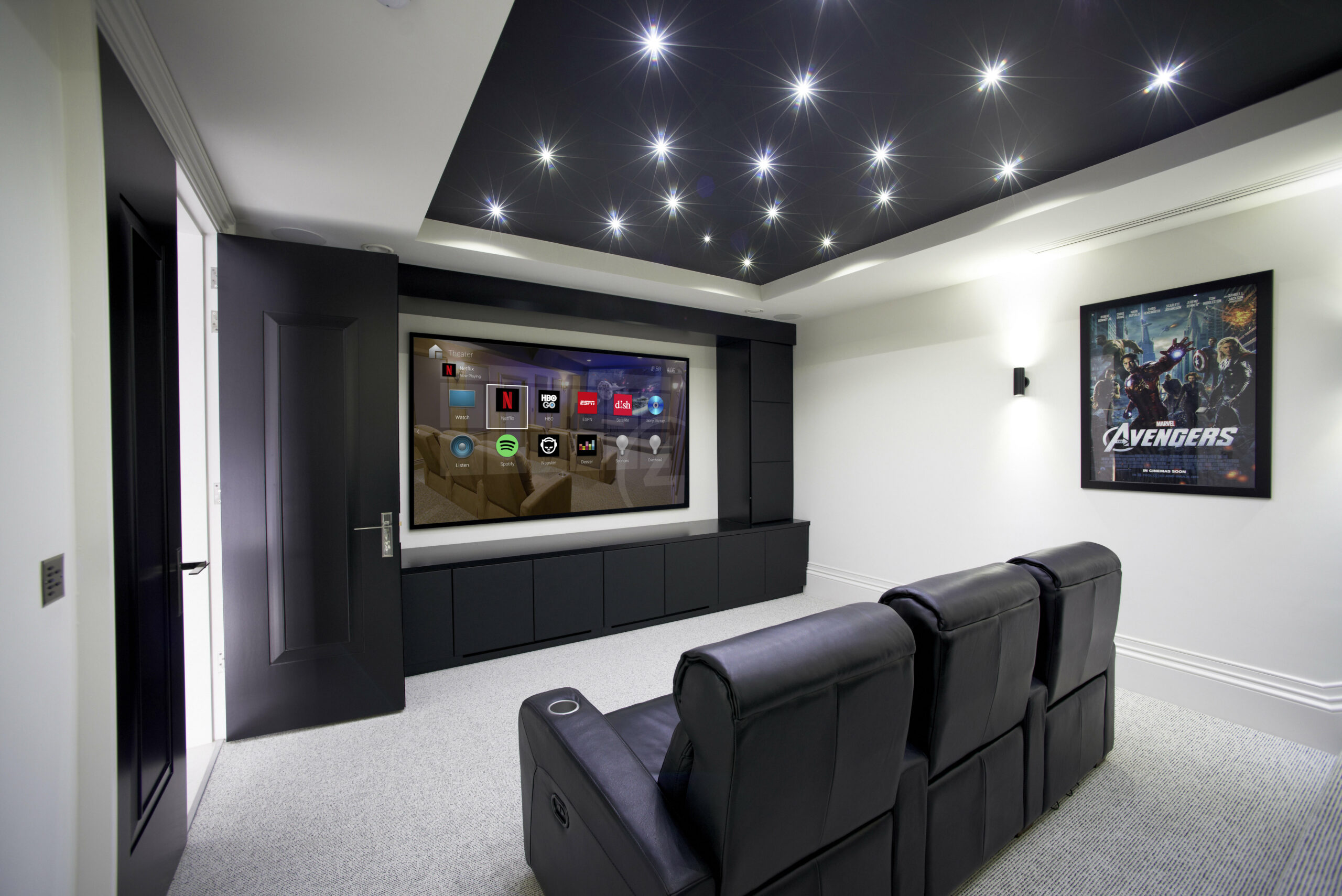


A home theater is the perfect place to bring your family and friends together for a fun night. It can turn a regular movie into a cinema-level experience with high-definition visuals, surround sound, and plush theater-style seats. But even better, it has all the comforts of home.
Since home theaters are a big project to undertake, figuring out the installation price is important for you to stay on budget. But because home theaters are highly customized, it's hard to give a price range that's a perfect fit for everyone.
Home theater prices can start as low as $2500 and go up into the high six figures – a range that doesn't narrow things down for most people. But understanding the factors that go into those prices can help you determine your costs.
Those factors are:
Hive designs and installs beautiful, smart home-ready theaters in homes across Tampa Bay, but we know we're not the best fit for everyone. This guide can be used by anyone who wants to take their home entertainment to the next level.
But with all of the different levels that home theaters can be, from small setups to big, dedicated spaces that rival your local theater, we should narrow down what a home theater is for the purpose of this article.
A home theater can mean several things, depending on who you ask. It can be a big OLED TV plus 5.1 surround sound speakers or a dedicated room with theater-style seating, a fixed projector screen, Dolby Atmos surround sound, and a popcorn machine – it can really be what you'd like it to be.
But most commonly, home theaters have any combination of:
Again, it can be whatever you'd like, making a home theater a viable addition for people with a range of budgets.
The size and layout of the room where you plan to install your home theater are fundamental factors in determining how much equipment you need and by extension, the cost.
A larger room may require additional speakers and amplifiers to create an immersive experience. You also may need a projector with a longer throw distance if your room is big enough. On the flip side, you might only need a little equipment for a smaller space.
Some room layouts and design features can add complexity to the installation process, potentially resulting in higher labor costs. For instance, if your ceiling is high, hardwiring might be more difficult, or if your electrical sockets aren’t close enough to your equipment, you might need to call in an electrician to help.
Room size can also affect your home theater's acoustic needs, which we'll explore next.
Have you ever been in a room that echoes to the point of distraction? Imagine putting a home theater in a space like that – it wouldn’t be a great experience.
Hard surfaces, outside noise, and high ceilings affect a room's acoustics – how sound interacts with a space.
You can adjust a room's acoustics by including soundproofing, wall treatments, or bass traps to keep your sound in your home theater and sounds from outside out. Home theater professionals can analyze the space and suggest tailored solutions to optimize sound reproduction, although it's an additional expense.
But it's a very worthwhile cost. Spending money on top-of-the-line speakers without using acoustic materials to improve that sound would mean not getting the most out of your equipment.
The audio and video are the most important aspects of your home theater, and with all the options available, they can be one of the biggest cost influencers too.
For video, you can choose a TV or a projector. Either option can be a good fit, depending on the situation.
Projectors are a better fit if you'd like a very large image (over 100 inches) and will use it in a dedicated space where you can have a fixed screen (though motorized ones that can be moved out of the way are an option). On average, projectors cost more, especially because you also need a screen to project onto.
TVs are a better fit for a multi-use room or if you want a smaller image. They're also easy to set up and cost-effective in comparison to projectors.
On average, you can expect the following costs for TVs and projectors:
Surround sound is essential for a great home theater. Without it, you can't get that movie theater experience. Surround sound in a home theater consists of:
You’ll often see numbers associated with surround sound, like 5.1 or 7.2. The first number is the number of speakers, while the second is the number of subwoofers in the system.
The cost of speakers and audio receivers depends on factors such as brand reputation, audio quality, and the number of output channels desired. In general, surround sound can start at around $1500 and go up from there, depending on how many speakers you’d like and the capabilities of those speakers.
The easy rule of thumb is that the higher-end options from brands with a good reputation tend to produce better sound quality and by extension, cost more. While budget-friendly options are available, it's important to strike a balance between your desired level of performance and your budget.
In the majority of cases, installing a home theater is something that should be left to the professionals for optimal results.
Connecting and programming a surround sound system and ensuring it connects to your TV and projector requires proper cable management, electrical work, and running wires. Those tasks usually mean going behind your drywall, too, something that most people need help doing.
Also, if you fully design your home theater, you’ll need someone to install the seats and acoustic treatments, though this aspect is much more manageable for the average person.
While some enthusiasts may take a DIY approach, especially if their systems are less complex, it's advisable to consult professionals to handle intricate wiring tasks. Some home theaters can be wireless, but hardwiring is the way to go for more powerful setups.
A home theater's design can recreate going out to the movies at home. Comfortable seating, smart lighting that can create the perfect ambiance, motorized shades, and even custom-built platforms can be a significant additional cost depending on the brand, material quality, and design complexity.
But like the rest of the aspects of a home theater, you can make your home theater design as simple or complex as you'd like. Maybe you just want a nice couch or stadium-style seating with custom shades, acoustic panels, and a starlit ceiling. With so many options, you can adjust the design to fit your budget.
Home automation systems can provide convenient control over various parts of your home theater, including lighting, audio, and video. It’s a great option if you’ve fully decked out your home theater. For instance, with a single press of a button, you can adjust your lights to the perfect level, put down your shades, and turn on your system. But with that convenience comes extra costs.
The complexity and extent of the automation you’d like will impact the cost. For instance, you’ll pay much less for a universal remote than a home theater that’s fully integrated into the rest of your smart home, which would require a smart home professional to program.
Designing and building a home theater can be a big project, but it doesn't have to mean spending an uncomfortable amount of money. By weighing the six factors that go into the cost of a home theater, you can strike a perfect balance between price and quality.
Since home theater installation is often best left to professionals, you may want to start by calling a pro who can help you find the budget for your specific situation. Keep the six factors we just discussed in mind in your discussion to ensure that you’re weighing the right options.
And if you plan to integrate your home theater into your smart home, keep these questions to ask a smart home professional handy to find the best collaborator for your project.
If you'd like a Hive professional to give you a free quote for a home theater, don't hesitate to get in touch with us at (813) 575-HIVE or fill out our consultation form here.